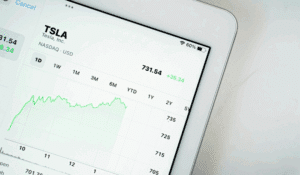Retail and wholesale businesses face constant challenges: rapidly changing trends, complex inventory management, and the need to juggle multiple sales channels. In this environment, financial agility is critical. The quick ratio acts as your business’s financial fitness test, measuring its ability to swiftly convert assets into cash to cover immediate debts.
This blog post provides a clear guide to calculating and interpreting the quick ratio. Whether you’re an e-commerce entrepreneur, a multi-channel retailer, or a wholesale distributor, understanding this powerful tool will empower you to ensure your business remains adaptable and resilient in the face of any challenge.

What is the Quick Ratio?
The quick ratio (or acid-test ratio) gives you a snapshot of your company’s liquidity position and short-term financial health. It shows how easily your business can pay off its immediate debts using only its most liquid assets. These assets include:
- Cash and cash equivalents: This is the most obvious one – money in the bank, petty cash, etc.
- Marketable securities: Think short-term investments like stocks and bonds that can be quickly sold.
- Accounts receivable: Money that customers owe you for goods or services they’ve already received.
Essentially, if a surprise bill landed on your desk tomorrow, could you pay it without having to sell off stock or scramble for a loan? That’s what the quick ratio reveals.
Quick Ratio vs. Current Ratio: What’s the Difference?
You might have heard of the current ratio, which also looks at your ability to cover short-term debts. The key difference? The quick ratio is more stringent. It excludes inventory and prepaid expenses from the equation. Why? Because inventory can take time to sell, and prepaid expenses are not liquid assets that can be used to settle debts. The quick ratio focuses solely on your immediate ability to pay debts using assets that are readily convertible to cash.
Why is the Quick Ratio Important for Retail and Wholesale Businesses?
Retail and wholesale businesses face unique challenges when it comes to managing liquidity. Inventory can be unpredictable, trends change rapidly, and seasonal peaks and troughs can create dramatic swings in cash flow. Add in the complexities of managing sales across multiple channels – online, in-store, and wholesale – and the need for financial agility becomes crystal clear.
This is where the quick ratio shines. By providing a clear picture of your readily available cash, it helps you:
- Ensure Financial Stability: A healthy quick ratio acts as a buffer, ensuring you can meet your immediate financial obligations – paying suppliers, covering payroll, and handling unexpected expenses – even during slower sales periods. This fosters stability and protects your business from short-term financial shocks.
- Improve Inventory Management: While the quick ratio doesn’t directly include inventory in its calculation, it can actually highlight potential inventory problems. A low quick ratio could be a warning sign that too much of your cash is tied up in slow-moving stock. This prompts you to analyze your inventory management practices.
- Support Growth Without Risking Cash Flow: Whether you’re planning to expand into new sales channels, launch a new product line, or invest in marketing campaigns, your company’s quick ratio helps you assess your financial capacity for growth. It ensures you can pursue opportunities without jeopardizing your ability to meet existing financial commitments.
The Quick Ratio Formula
Calculating the quick ratio is surprisingly straightforward. Here’s the formula:
Quick Ratio = (Cash and Cash Equivalents + Marketable Securities + Accounts Receivable) / Current Liabilities
Let’s break down each component:
- Cash and Cash Equivalents: These represent your business’s most highly liquid assets. They include cash on hand, money in your bank accounts, and short-term investments that can be readily converted to cash.
- Marketable Securities: These are short-term investments that can be easily sold on the open market, such as stocks and bonds. They represent another source of quick cash for your business.
- Accounts Receivable: This is the money owed to your business by customers who have purchased goods or services on credit. While not as immediately liquid as cash, it’s still considered a quick asset as these payments are expected to be collected in the near future.
- Current Liabilities: This encompasses all the short-term debts your business needs to pay within the next year. This typically includes accounts payable (money owed to suppliers), short-term loans, and accrued expenses.
By dividing the sum of your quick assets by your current liabilities, you get a clear picture of your company’s ability to meet its immediate financial obligations without relying on the sale of inventory or long-term assets.
Step-by-Step Guide to Calculating the Quick Ratio
Now that you understand the components of the quick ratio, let’s walk through how to calculate it for your own business.
1. Gather Your Financial Data
Start by gathering the necessary information from your company’s balance sheet. You’ll need the figures for:
- Cash and cash equivalents
- Marketable securities
- Accounts receivable
- Current liabilities
2. Add Up Your Quick Assets
Sum the values of your cash and cash equivalents, marketable securities, and accounts receivable. This gives you the total value of your quick assets.
3. Calculate Your Current Liabilities
Identify all your short-term obligations that are due within the next 12 months. This typically includes accounts payable, short-term loans, salaries payable, and any other debts due in the near future.
4. Apply the Formula
Plug the numbers you’ve gathered into the quick ratio formula:
Quick Ratio = (Cash and Cash Equivalents + Marketable Securities + Accounts Receivable) / Current Liabilities
5. Interpret the Result
The quick ratio is typically expressed as a number. Here’s a general guideline for interpreting the results:
- Less than 1: This suggests that your company may struggle to meet its short-term obligations without selling inventory or relying on other financing. It’s a signal to investigate your cash flow and working capital.
- Equal to 1: This indicates that your company has just enough liquid assets to cover its current liabilities. While not necessarily a cause for alarm, it leaves little room for unexpected expenses or downturns.
- Greater than 1: This is generally considered a healthy quick ratio. It means your company has more than enough quick assets to cover its short-term debts, indicating good financial stability and flexibility.
Keep in mind that the ideal quick ratio can vary depending on your industry, business model, and specific circumstances. It’s always best to compare your ratio to industry benchmarks and track it over time to identify trends and potential areas for improvement.
A Quick Ratio Example
Let’s imagine a hypothetical online retailer, “Fashion Forward,” that sells clothing and accessories through its own website and a popular online marketplace. Here’s a simplified version of their balance sheet:
- Cash and cash equivalents: $50,000
- Marketable securities: $20,000
- Accounts receivable: $30,000 (includes $10,000 pending from the online marketplace with a 30-day payout delay)
- Current liabilities: $60,000
Now, let’s calculate Fashion Forward’s quick ratio:
- Calculate Quick Assets: $50,000 (Cash) + $20,000 (Marketable Securities) + $30,000 (Accounts Receivable) = $100,000
- Apply the Formula: $100,000 (Quick Assets) / $60,000 (Current Liabilities) = 1.67
Fashion Forward’s quick ratio of 1.67 demonstrates strong liquidity, which is a positive indicator of the company’s financial health. They have more than enough liquid assets to cover their immediate debts.
E-commerce Considerations
For e-commerce businesses like Fashion Forward, it’s important to factor in any delays in receiving payments from online marketplaces. In this example, $10,000 of the accounts receivable is pending from the marketplace with a 30-day payout delay.
If Fashion Forward anticipates a potential cash flow crunch within the next month, it might be prudent to adjust the accounts receivable figure to reflect the delayed payment. This would provide a more conservative estimate of their immediate liquidity.
Adjusted Quick Ratio Calculation:
- Adjusted Quick Assets: $50,000 (Cash) + $20,000 (Marketable Securities) + $20,000 (Adjusted Accounts Receivable) = $90,000
- Apply the Formula: $90,000 (Adjusted Quick Assets) / $60,000 (Current Liabilities) = 1.5
Even with the adjusted calculation, Fashion Forward still maintains a healthy quick ratio, demonstrating the importance of considering payment cycles in e-commerce.
Best Practices for Improving Your Quick Ratio
While understanding the quick ratio is crucial, taking action to improve it is where the real benefits lie. Here are some practical strategies for retail and wholesale businesses to boost their quick ratio and strengthen their financial standing:
Reduce Unnecessary Expenses
Take a close look at your operating costs and identify areas where you can cut back without impacting core business functions. This might involve negotiating better rates with suppliers, optimizing energy consumption, or streamlining administrative processes. Every dollar saved contributes to a healthier cash flow and a stronger quick ratio.
Master the Art of Inventory Management
Inventory often represents a significant portion of a business’s assets, and mismanaging it can tie up valuable cash. Implement robust inventory management practices to optimize stock levels, minimize holding costs, and reduce the risk of obsolescence. Utilize forecasting tools, implement just-in-time inventory systems, and consider strategies like dropshipping to minimize the capital tied up in inventory.
Speed Up the Cash Cycle
The quicker you collect payments from customers, the better your liquidity. Offer incentives for early payments, such as discounts or loyalty rewards. Implement efficient invoicing systems and explore options like online payment gateways and mobile payment solutions to expedite the payment process.
Leverage Real-Time Financial Tracking
Modern technology offers powerful tools to monitor and manage your finances in real-time. Cloud-based accounting software, inventory management systems, and financial dashboards provide up-to-the-minute insights into your cash flow, accounts receivable, and overall financial health. This allows you to identify potential issues early on and take proactive steps to maintain a healthy quick ratio.
Tools to Simplify Quick Ratio Calculations
Manually tracking and calculating your quick ratio can be time-consuming and prone to errors. Fortunately, tools like Brightpearl offer robust features that can automate this process and provide valuable insights into your business’s financial health.
Brightpearl, with its integrated approach to business management, simplifies quick ratio calculations and provides a holistic view of your financial performance.
Here’s how Brightpearl can help:
- Centralized Financial Data: With all your current assets and liabilities housed in one system, Brightpearl streamlines the process of calculating financial metrics like the quick ratio.
- Automated Reporting: Brightpearl can automatically generate reports on your quick ratio and other key financial metrics, saving you time and reducing the risk of errors.
- Real-Time Insights: Access up-to-the-minute data on your financial performance, allowing you to proactively monitor your quick ratio and identify potential issues early on.
- Improved Inventory Management: Brightpearl’s powerful inventory management features help you optimize stock levels, reduce holding costs, and free up cash flow, which directly impacts your quick ratio.
By leveraging a system like Brightpearl, you can streamline your financial management, gain a deeper understanding of your business’s liquidity, and make data-driven decisions to support your growth.
Stay Quick on Your Feet: The Power of the Quick Ratio
Retail and wholesale businesses face a unique set of financial challenges. The quick ratio is a critical tool for navigating these challenges and ensuring your business remains agile and resilient.
By understanding and regularly monitoring this key metric, you gain valuable insights into your short-term liquidity, allowing you to:
- Proactively manage cash flow
- Identify potential financial risks
- Make informed decisions about growth and expansion
Don’t let your business get caught off guard. Take control of your financial health and ensure you have the resources to adapt and thrive in any market condition.
Ready to streamline your financial management and optimize your business’s performance? Brightpearl not only helps you calculate your quick ratio, but also offers features that directly improve it – from automated reporting and real-time financial insights to robust inventory management tools. Book your demo today!




